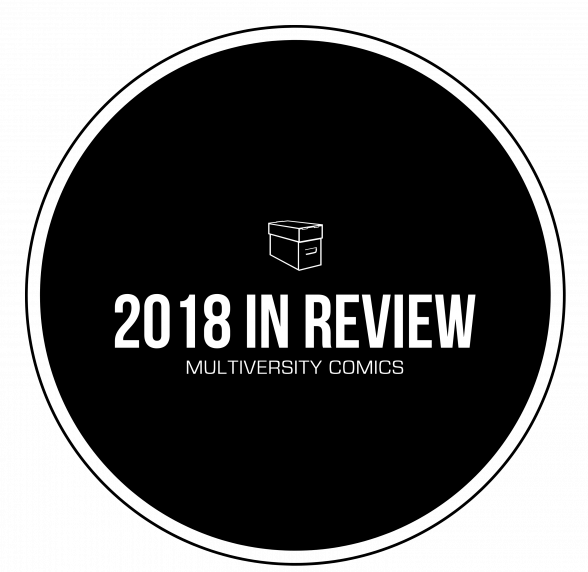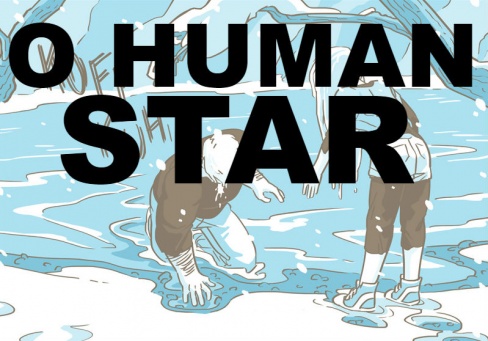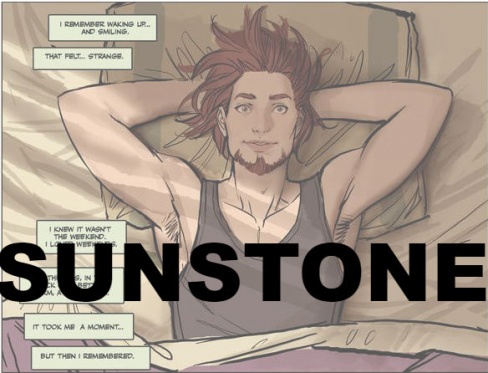
One of our goals, as a site, for the last few years has been to do more with webcomics. This is the first year it has felt like an integral part of our site, and we’re really proud of that.
3. O Human Star (tie)

There are a lot of webcomics out there, all of which are worthy of your time and Patreon pledges but there are fewer that have managed to maintain the consistent level of quality that “O Human Star” has. Running for close to 6 years, Blue Delliquanti’s tale about AI, identity and struggling with accepting who you are and, possibly, fighting who society expects you to be is thoughtful, slow, and driven by its ineffable cast. On its surface, the story is about the mysteries surrounding Alastair Sterling, one of our three focal character’s, death and rebirth.
However, as Blue delves deeper into the fractured relationships between Alastair, Brendan and Sula, both in the past and the near-future, the story expands upon us. This balance helps the story of “O Human Star” to stick with you long after you’ve closed the pages. It remains, asking you to think about the ways in which we ask others to pretend to be who they are not, asking how we can better shape the world to reflect the multitudes of those around us.
The choice to tell two parallel narratives, one concerned with who these characters are and the other with how they came to be, is another reason this comic sticks with you long after it is gone. But why this year, then? What made “O Human Star” stand out this year? It was the resolution to Sulla’s past narrative, of her putting into words her identity as a trans woman, and the messiness of that conversation because of Brendan’s flaws. The questions that this year’s pages grapple are difficult but ultimately hopeful; they are fully-formed, nuanced, and thought-provoking, which is what all the best science fiction does.- Elias Rosner
3. Nancy (tie)

“Sluggo is Lit.” The words that really kickstarted this comic up the charts.
Comics is a medium that needs to change and evolve, no matter how much the old guard (usually people who are white and cisgendered male) gnash at it. Evolution is even more important when your comic property has been going on for nearly a century. It’s even super-duper-duper more important when you’re a newspaper comic strip (then moved to GoComics), 90% of which are pretty arrogant to call themselves “funny.”
Enter the writer/artist pseudonymous Olivia Jaimes onto the property. The first woman to helm the strip (a fact which is just another gripe a lot of idiots have) who had the audacity to add things like “cell phones” to the comic. Naturally, it’s more than just technological updates. Jaimes brings an at times charming, at times sly and deadpan humor, an art style that reinforces that tone (including a much appreciated design update on Aunt Fritzi), and an understanding of the memetic culture that exists in 2018.
“Nancy” by Jaimes is an example of how to revamp and update a property that could’ve easily gone the way of the dinosaurs successfully. That it also pissed off a bunch of gatekeepers is just whip cream on top. – Ken Godberson III
2. A Problem Like Jamal

The comic strip is one of the most recognizable formalist tool in the medium. It defines a sub-genre and while it is generally used for humor, the format is as versatile as any other. Case and point: “A Problem Like Jamal” by Tauhid Bondia.
A relative newcomer to the webcomics scene, starting up back in June, “A Problem Like Jamal” has wasted no time in channeling one of the format’s greatest, “Calvin and Hobbes,” and filtering the same tensions, worries, and imagination through the eyes of a black kid in 2018 instead of a white kid in the late 80s. The first few strips are heavily reminiscent of Calvin’s tirades against his teachers and the school system in terms of tone & the set-up of the joke but with a more socially conscious perspective. Jamal isn’t just a smart kid bucking against a system designed to produce conformity to the prescribed narrative; he’s also fighting the institutional racism of the system all from from a child’s perspective; tacos in the lunchroom take precedence over fighting the good fight.
Continued belowHowever, this is not what propelled the comic to #2. What propelled it here is the most recent arc. Up until then, the comic relied on a winning formula of utilizing the three to four panel structure, broken up by longer Sunday strips, to tackle, through humor, tough issues of race and class. However, this most recent arc took a turn for the serious, as indicated by the removal of the three-four panels and replaced by single images with minimal text. It is striking and arresting and helped frame the return to the formula, redefining it and strengthening the core of the series. I firmly believe that the best humor comes from a place of shared pain; Jewish humor is melancholic and born from suffering, and “A Problem Like Jamal” gets that intently, making sure not to make light of tragedy but to use that to fuel it’s humor.
As with all webcomics, and all art, there is evolution in the storytelling, a finding of one’s own voice and a refining of one’s skills. Even in just these short six months, “A Problem Like Jamal” encapsulates Bondia’s growth as an artist, from the linework to the coloring to the sharpness of the commentary. In a category that usually highlights the highly-detailed, the long-term, and intricately, densely plotted, it’s always important to remember that comedy can be just as potent as tragedy. – Elias Rosner
1. Order of the Stick (tie)

For over a thousand pages, Rich Burlew’s “Order of the Stick” has been crafting a story that’s equal parts epic fantasy adventure, fourth wall-breaking comedy, and Dungeons & Dragons parody. Each element is blended perfectly, all brought together in a cartoonish stick figure art style that’s still managed to improve throughout its run.
In the years since “Order of the Stick” has begun, it’s gone through several arcs and adventures, all within a continuous narrative with worlds at stake. The worldbuilding in the webcomic has been incredible – the way it slowly builds upon its mythology and overall world over time, introducing each element in a way that fits naturally with the storyline, has crafted a deep world and mythos even within the comedic story.
Even the way it makes Dungeons & Dragons mechanics a part of the world is hilarious and internally consistent. While the humor has relied less and less on it as time has gone by (in part due to the comic running long enough to have used all the jokes), it’s still a vibrant part of the comic’s world. Characters rely on skill checks and attack rolls, they level up in classes and take feats, and their lives are determined by being player characters or NPCs.
Speaking of characters, “Order of the Stick” has some of the most memorable adventurers and adversaries I’ve ever read. Every member of the Order has seen great levels of character development (perhaps the best of all being Belkar, the murderous halfling ranger, who even acknowledges that growth like his happens so slowly over time that it’s hard to even pinpoint when he changed) and goes through arcs important to their stories. Whether it’s Elan meeting his father then subsequently rebelling when he learns his dad is evil, Durkon’s sacrifice and its consequences, or Vaarsuvius dealing with the fallout of their deal with devils, every single character has a great story behind them.
This even extends to secondary characters, although many of those stories are not yet complete. The Monster in the Darkness is still undergoing his character arc (and we still don’t know what’s behind the darkness), Redcloak is still plotting his own schemes, and now even the gods themselves have stories and backstories intermingling with the rest of the plot.
The most recent arc, which seems to be nearing its end, is one of the most emotionally powerful moments the comic has had yet. Seeing a beloved character struggle for control of his own body against his vampiric self, seeing how the Order of the Stick reacts to the truth of his loss and betrayal, and the way the story ends, all hits the readers hard. Yet with it all said and done, everything still ties together into the overarching story of the Snarl. It’s expertly crafted.
Continued belowFor a webcomic built around characters with stick figure limbs, the art evolution is noteworthy as well. Rich Burlew is a talented artist, and the simplistic style is an intentional artistic choice. It adds to the mood and tone, keeping things bright and entertaining without bogging things down with excessive detailing.
Yet over time we’ve been given clear jumps ahead in art styles, with more given to the characters designs, armor, and even whether or not their arms and legs are drawn with straight lines or given more depth. Little moments of detail and shading, like the green flames of Roy’s family sword illuminating the surroundings, add to the visuals while still remaining consistent with the style.
While “Order of the Stick” began during 3.5 edition of Dungeons & Dragons, the webcomic has continued strong even as D&D has gone through 4th edition and made its way to 5th. The comic’s longevity is a testament to Rich Burlew’s talents as a storyteller and artist, making it a must-read for any fan of tabletop games. All the characters, adventures, side quests, and jokes he’s written have created an unforgettable world. The quest hasn’t ended yet, and as “Order of the Stick” moves on to the next part of its story, we can look forward to a thousand more pages of adventure. – Robbie Pleasant
1. Sunstone (tie)

2018 saw writer-artist Stjepan Sejic continue his jaunt with DC, drawing several issues of a book before having to redraw them, and several bouts of the flu, throughout the year “Sunstone: Mercy” seemed to act as a creative release valve as he plugged away at all manner of project. The release schedule may not have been as consistent as other strips, Sejic still produced 109 pages as of this writing, but when it was released it made an impact. Impact enough for it to tie for Multiversity’s best webcomic of 2018.
“Mercy” in 2018 has been about sexual awakenings. Alan and Ally, after their rope fueled meet cute, began to explore BDSM proper on a college-poor budget. Meanwhile Anne realized her bisexuality and began to explore it with fellow metalhead Laura. Through all of this Sejic’s strong handle on his characters and how they bounce off one another has been the real treat of this erotic strip. Reading Alan and Ally work through their feelings, and lack of romantic feeling, in their current relationship is just as entertaining as the sumptuous images of what they do with one another. Anne’s backstory, coming out to her father, and the butterflies fueled courtship with Laura make their first kiss play even better. These underpinnings have helped this story side step the general pitfalls of prequel writing, where characters and relationships can have an air of fait accompli, and read like a thematically appropriate expansion of “Sunstone.”
The strip containing pages 035-54 is among the favorite things I’ve read all year regardless of medium. In those 19 pages we get a history of how Anne and Cassie became friends, a meetcute, and Anne recognizes something new about her self and goes for a test drive, all set against a Nightwish cross Wicked metal concert! Sejic goes through more emotionally revelatory plot points in 19 pages than some comics do in two arcs, and the strip isn’t lesser for it. The moments of Anne’s realization strikes true in a way that just felt good an affirming the same way David “Prodigy” Alleyne talking about his bisexuality was. It is a dense strip that doesn’t was an inch.
The act of reading has also been a fun change of pace compared to other web strips. Sejic made the call to just make everything formatted to typical comic page instead of drawing everything as free form strips and reformatting for latter publication. His strips are still read vertically, like most webcomics, but composing them as comic pages adds a left to right reading perspective at time that makes for a more efficient use of the infinite digital canvas. While “Mercy” will eventually be published as an OGN, Sejic’s releases work extremely well as episodic strips that left me hanging on every word and wanting more every time I reached the bottom of his DeviantArt page.
Continued below– Michael Mazzacane
Editors’ Notes:
Matt: The biggest problem with webcomics is that there’s just so many of them. But, at the same time, it’s such a wild subsection of the medium, which makes webcomics some of the consistently most exciting comics. Cartoonists and creators have the chance to experiment, to push the form, to make something interesting without the overbearing sight of an editorial committee. The entries here aren’t even a sliver of what the webcomics spectrum has to offer but, in their own way, they all show the potential for the format. They’re queer and sexy and long and hysterical.
Brian: This list is a lot of fun and super diverse and yet, as Matt said, this barely scratches the surface. It can be overwhelming to try to keep up with the world of webcomics, but it is undoubtedly where some of the most bold, innovative comics are happening. Find the time and make the effort, and you’ll be rewarded.






